As I write these lines, I am sitting in ICE 228 to Dortmund. People are traveling with me, fleeing the murderous war in Ukraine. They are tired, exhausted – but safe. A woman traveling with a baby has an injury to her face, caused by splinters from a shell.
Russia’s army, which is invading Ukraine, has been upgraded for years. In 2020, it ranked eighth in the world according to the Global Militarization Index; according to the Global Firepower Index, Russia has the second most powerful armed forces and the strongest army in the world. In this research into Austrian and Russian company books and annual reports, we show that part of Russia’s weapons production was the responsibility of an „Austrian manager“: we will be talking about Siegfried Wolf.
Publicly Wolf denies ever having had anything to do with military production. We received no answer to a Semiosis inquiry to his media spokesman Josef Kalina. But others did.
Research by Tano Bojankin and Sebastian Reinfeldt. [Update 3/18/2022 and extended 3/20/2022] This is the English version of Diese Technik ist der Stolz Russlands
In Russian service
Siegfried Wolf (born October 31, 1957 in Feldbach) is an Austrian manager.
https://de.wikipedia.org/wiki/Siegfried_Wolf_(Manager)
This is the first sentence of the Wikipedia entry about the Austrian businessman who is probably the most intensive of all local businessmen in the service of powerful Russian companies. Well known are his activities for Sberbank (whose European chairmanship he is said to have resigned in the meantime), for Russian Machines and for GAZ-Group. What is not really clear from the Wikipedia entry is that Siegfried Wolf was close to Russia’s military-industrial complex. Very close, in fact. It seems hard to imagine that the production of military equipment in the companies where he held responsibility passed him by without him noticing.
An Austrian backstory: Camouflaged arms trade
The Austrian arms company Hirtenberger traces its origins to the so-called Munitions Triangle, which was established in the Vienna Basin under Empress Maria Theresa. In the 1980s, the company was involved in the Noricum scandal as part of the nationalized industry. During the first Gulf War (1980 to 1988), the latter wanted to sell the GHN-45 field howitzer (Gun Howitzer Noricum) to both sides, Iraq and Iran. According to a statement by then-Chancellor Bruno Kreisky, the illegal arms deal was to be handled camouflaged.
However, the scandal blew up and led to a long court case and parliamentary investigations. Siegfried Wolf’s career began in this company: from 1983 to 1995, he worked his way up at Hirtenberger from department head to division manager and plant director to authorized signatory.

The next stop on his career ladder, Magna Steyr, was on the list for ominous countertrade deals for the Eurofighter.

Russian Machines is a basic element
Siegfried Wolf left Magna in November 2010. His next career step took him directly to Russia, and to a giant corporation at that. He became Chairman of the Supervisory Board of Russian Machines, the conglomerate of the powerful oligarch in Putin’s closest circle, namely Oleg Deripaska. Via this connection, he joined the supervisory board of STRABAG, in which Deripaska also holds a stake, from 2007 to 2015.
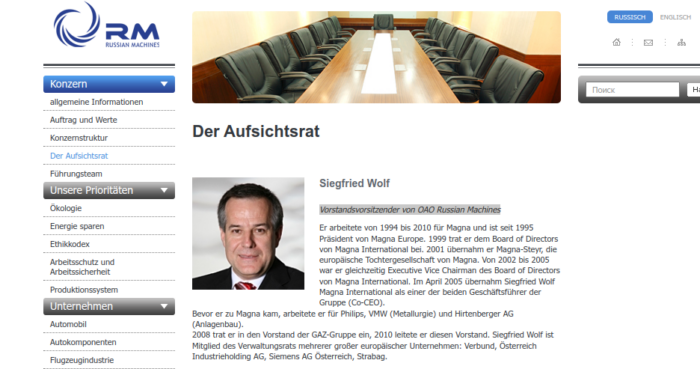
What does Russian Machines actually produce? The conglomerate – established in 2011 – currently manufactures mechanical engineering products including motor vehicles, car parts, rail cars, aircraft, farming and construction equipment in 27 factories throughout Russia. The product range also includes military equipment in affiliated subsidiaries.
Russian Machines, in turn, itself has a parent company called Basic Element, which is owned by Deripaska. Russian Machines also includes the GAZ Group, which is often inaccurately referred to as a car company, and the Military Industrial Company (MIC), which is also a wholly owned subsidiary of Russian Machines. The name of the Military Industrial Company already indicates that it mainly manufactures military equipment.
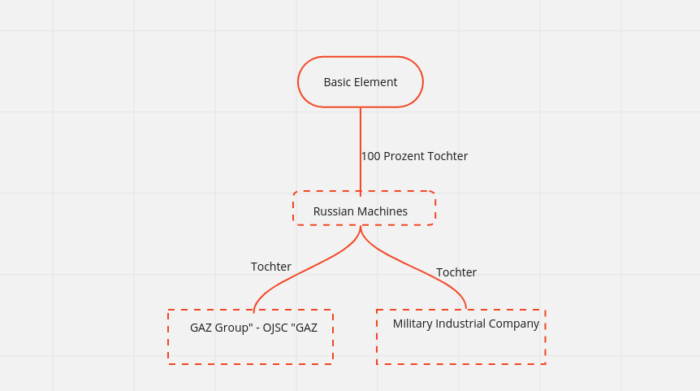
Chairman of the Supervisory Board of a producer of military equipment
Siegfried Wolf has dealings at all levels with the companies on this sketch. Sometimes more, sometimes less.
On August 20, 2018, the Russian agency Interfax reported an extraordinary meeting of the GAZ Group’s shareholders. They appointed the co-owner (he owns about 10 percent in it, according to ORF in Bild 2 on March 15, 2022) and chairman of Russian Machines, Siegfried Wolf, as chairman of the supervisory board of GAZ Group. With him, a new supervisory board was immediately appointed.
In June 2021, Vitesco Technologies report that Siegfried Wolf has also been elected to their Supervisory Board. In the appendix of the report they publish his curriculum vitae. It states:
He also served as Chairman of the Board of OJSC GAZ Group (2010-2019). From 2011 to 2014, he also supervised the construction assets of Basic Element Group. Professor Wolf sits on the supervisory boards of several leading international companies (Porsche SE, Continental AG, Schaeffler AG, MIBA AG, CMBlu Energy AG) and is Chairman of the Board of Sberbank Europe AG. In June 2020, Professor Wolf was reappointed as a member of the Supervisory Board of OJSC GAZ Group.
Never worked in the military field?
In Austria, Wolf took over the MAN plant in Steyr in mid-2021 and renamed it Steyr Automotive. His takeover bid was politically and economically controversial. It remains unclear what would actually be produced in the future at the plant, which was previously in the black. Steyr will continue to produce for the German MAN Group until mid-2023. In this context, the newspaper Kurier reports that a cooperation with the Russian Wolf subsidiary GAZ is planned from mid-2023.
In the same article there is an exciting announcement by Wolf:
Wolf let it be known that he had already resigned from all functions in the Russian company „Russian Machines“ for more than three years. He pointed out that „even before that, he had never worked in the military sector.“
He was referring to a report in the Handelsblatt. The business newspaper had pointed out that Russian Machines had supplied the Russian Air Force, among others.
A permanent representative in Vienna
In this context, the GAZ Group’s branch office in Vienna is also interesting. According to the current excerpt from the company register, its business objective is to „research the market economy and public opinion.“ It is permanently represented by: Siegfried Wolf.
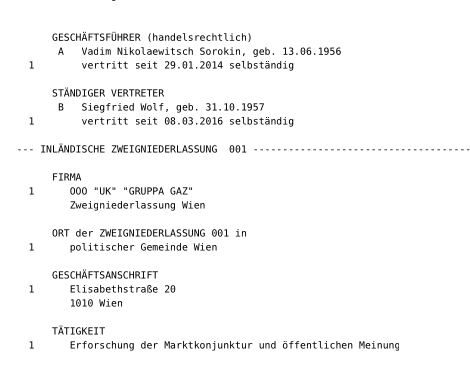
In the portfolio of production of GAZ Group in the period before this war there are models which are now used in Ukraine. Thus, the GAZ „Tigr“.
Wikipedia lists eights sources that indicate:
From 22th of july 2019, 169 „Tigr STS“ und 107 „Tigr-M“ have been in service of the Russian army.
A model from its production was already spotted in the Donbass in 2016, at the beginning of Russia’s hybrid aggression against Ukraine. With identification of the Russian military.
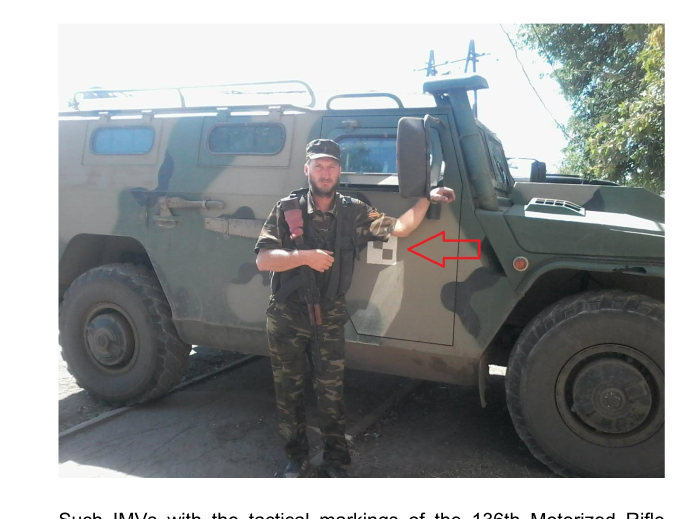
On Twitter, but also through the agencies, are currently constantly ticking pictures of destroyed Tigr vehicles, which are abandoned on the roadside in Ukraine.
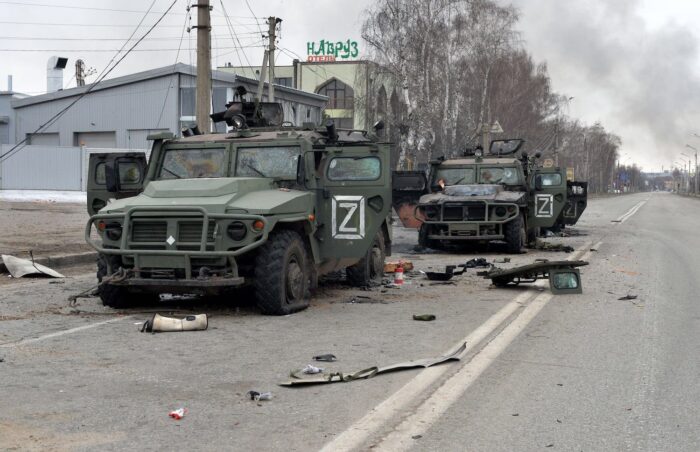
Siegfried Wolf is not only a shareholder in the GAZ Group, he is its permanent representative and chairman of the supervisory board. Is it then credible that he has never been active in the military field?
Advanced models of the world weapons market
Even more closely connected to the production of military equipment is the Military Industrial Company, a subsidiary of Russian Machines, of which Siegfried Wolf was Chairman of the Board. From this division, we present a factory which, according to its own information, produces
advanced models for the world weapons market
https://web.archive.org/web/20201031034215/http://www.amz.ru/o-predpriyatii/
Arzamas Machine-Building Plant JSC. It belongs directly to the Military Industrial Company. A look at the models it offers reveals important equipment of the Russian arsenal currently being used in Ukraine. After all, this arsenal has not been produced in the past weeks and months, but it goes back years. In a moment, we will see an excerpt from the company’s catalog, which we have made visible via a wayback machine. It is preceded by Vladimir Putin’s quote, which is the title for us:
This technology is Russia’s pride, and this is a visible proof of the enormous potential of our military-industrial complex – scientific potential, personnel and production.
https://web.archive.org/web/20201101120957/http://www.amz.ru/bez-rubriki/produktsiya/
Accordingly, the following military vehicles are in production there:
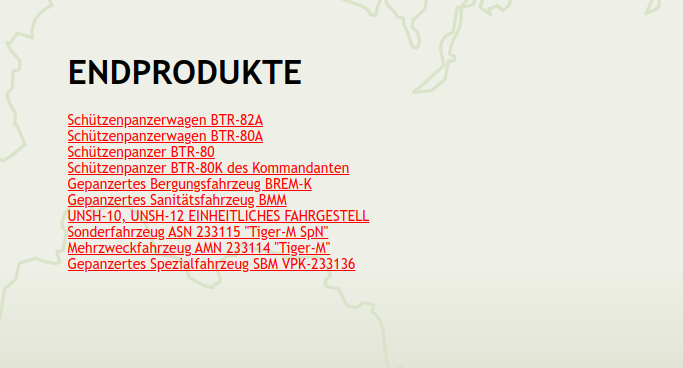
- armored personnel carrier BTR-82A
- armored personnel carrier BTR-80A
- armored personnel carrier BTR-80
- armored personnel carrier BTR-80K
- armored recovery vehicle BREM-K
- armored mountain rescue vehicle BREM-K
- armored ambulance BMM
- UNSH-10, UNSH-12
- special vehicle ASN 233115 Tigr-M SpN
- multipurpose vehicle AMN 233114 Tigr-M
- armored special vehicle SBM VPK-233136
Among them, we find the BTR 80 infantry fighting vehicle, and here we see a model abandoned by Russian troops in Ukraine.
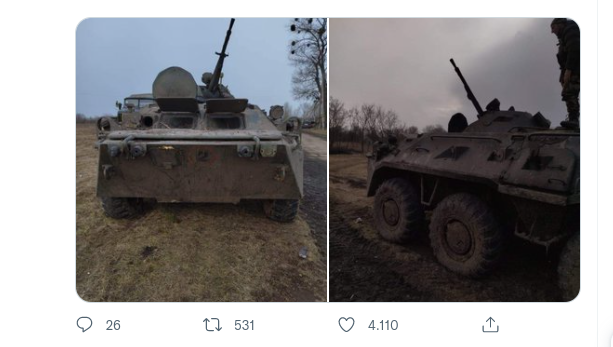
Wikipedia (German version) lists the numbers of vehicles which are in service in the Russian army:
Ground forces – As of 5th of July, 1499 BTR-80, 100 BTR-80A and 1080 BTR-82A/M are in service.[7][8][9][10]
https://de.wikipedia.org/wiki/BTR-80
Marines – Since 19th of September 2019, at least 760 BTR-82A/M are in service.[11][12][13][14][15]
Airborne troops– January 2018, at least 20 BTR-82AM were in service.[6]:200
Missile troops – By end of December 2017, 26 „Taifun-M“ on the basis of BTR-82 were in service.[16]
These connections raise a number of questions. Some of them we have addressed to the media representative Wolfs. Without answer.
Our unanswered questions to Siegfried Wolf
Sent on Friday, March 11, 2022 to media representative Wolfs, Josef Kalina:
1) Is Siegfried Wolf currently a member of the Supervisory Board of OJSC GAZ Group? If not: when did he resign from this position and how?
2) GAZ Group has, besides commercial vehicles, a wide range of military equipment (from trucks to tanks). I would like to know how involved Mr. Wolf was in this line of business.
3) In this context, a question arises on the now terminated activity as sole executive for Russian Machines. This company, through its subsidiary Military Industrial Company (ООО Военно-промышленная компания), is also directly involved in the development of armored vehicles.
To what extent did Mr. Wolf help to establish this line of business or work on it?
[Update 18th of march 2022] Our colleagues from the technical journal Traktuell had more luck in receiving answers to their quite similar questions.
Josef Kalina, the speaker of Siegfried Wolf, confirmed the existence of such vehicles. But he denied the involvement of the GAZ company, that was within Wolf’s area of responsibility. Military production was organized through subsidiary companies, which were split off 2011. The production of GAZ nowadays is concentrated on civil vehicles. That the name GAZ occurs in the model’s designation has nothing to do with the production of this military vehicles.
Source: https://traktuell.at/news/war-die-russische-gaz-in-die-ruestung-involviert/
This explanation is highly questionable, though, for a) it excludes Wolf’s activities at Russian Machines company. It is hardly conceivable that the executive director of such an enterprise has nothing to do with the production of military vehicles in a subsidary company which is hundred percent in the hand of its parent.
Moreover, it seems like a prevarication to append the name GAZ of the vehicles as a tradition.
GAZ confirmes GAZ not to be involved in military production
The explanations Wolf offers via the APA-OTS channel (which is the Austrian original-text-service, so there was no investigation) are even more interesting. He presents a „clean bill of health“, issued by Alexander Gorlov, saying:
I am writing to confirm that GAZ – Group does not manufacture military vehicles, machines or any other type of military products. Starting with the end of the Soviet era in the early 1990s, the GAZ Group’s strategy was to part with the manufacture of military products and thus with the Soviet past. The GAZ – Group completed this process in the early 2000s.
Source: https://www.ots.at/presseaussendung/OTS_20220316_OTS0116/siegfried-wolf-haelt-fest-war-niemals-in-militaerische-produktion-involviert
Of course, this clean bill of health does not only refer to Wolf’s activities. The production of the GAZ is completely harmless, so the GAZ confirms about itself. The strange thing is, the group has been affected by US sanctions since 2018 (!). Nevertheless, it has not managed to disappear from the sanction’s list since then. The announcement by the US Treasury Department, Treasury Designates Russian Oligarchs, Officials, and Entities in Response to Worldwide Malign Activity on April 6, 2018, reads clearly:
Russian Machines is being designated for being owned or controlled by, directly or indirectly, Oleg Deripaska and Basic Element Limited. Russian Machines was established to manage the machinery assets of Basic Element Limited.
Basic Element Limited is being designated for being owned or controlled by, directly or indirectly, Oleg Deripaska. Basic Element Limited is based in Jersey and is the private investment and management company for Deripaska’s various business interests.
GAZ Group is being designated for being owned or controlled by, directly or indirectly, Oleg Deripaska and Russian Machines. GAZ Group is Russia’s leading manufacturer of commercial vehicles.
Source: https://home.treasury.gov/news/press-releases/sm0338
Since 2018, the companies for which Siegfried Wolf worked at the highest level have been subject to US sanctions.
Apparently, in Austria, the public did not look too closely. In turn, Wolf remained a well-respected man in the country. A man, who, as a so-called „Austrian solution“, was supposed to save the MAN factory in Steyr before „alien companies“ took over.